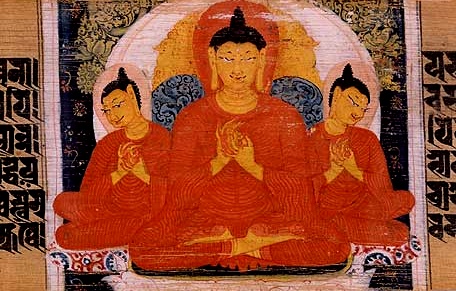|
Miracles Of Gautama Buddha
The miracles of Gautama Buddha refers to supernatural feats and abilities attributed to Gautama Buddha by the Buddhist scriptures. The feats are mostly attributed to supranormal powers gained through meditation, rather than divine miracles. Supranormal powers the historic Buddha was said to have possessed and exercised include the six higher knowledges ('' abhiññā''): psychic abilities (''iddhi-vidhā''), clairaudience (''dibba-sota''), telepathy (''ceto-pariya''), recollection of one's own past lives (''pubbe-nivāsanussati),'' seeing the past lives and rebirths of others (''dibba-cakkhu''), and the extinction of mental intoxicants ('' āsavakkhaya''). Miracles found in Mahayana sutras generally play a more direct role in illustrating certain doctrines than miracles found in non-Mahayana Buddhist texts. Apart from texts, several of the miracles are often shown in scenes of the life of Buddha in art. Stories of Gautama Buddha's miracles include miraculous healings, teleportat ... [...More Info...] [...Related Items...] OR: [Wikipedia] [Google] [Baidu] |
Rice Pudding
Rice pudding is a dish made from rice mixed with water or milk and other ingredients such as cinnamon, vanilla and raisins. Variants are used for either desserts or dinners. When used as a dessert, it is commonly combined with a sweetener such as sugar. Such desserts are found on many continents, especially Asia where rice is a staple. Some variants are thickened only with the rice starch; others include eggs, making them a kind of custard. Rice pudding around the world Rice puddings are found in nearly every area of the world. Recipes can greatly vary even within a single country. The dessert can be boiled or baked. Different types of pudding vary depending on preparation methods and the selected ingredients. The following ingredients are usually found in rice puddings: * rice; white rice (usually short-grain, but can also be long-grain, broken rice, basmati, or jasmine rice), brown rice, or black rice * milk (whole milk, coconut milk, cream or evaporated) * spices (cardam ... [...More Info...] [...Related Items...] OR: [Wikipedia] [Google] [Baidu] |
Kapilavastu (ancient City)
Kapilavastu was an ancient city in the north of the Indian subcontinent which was the capital of the clan ''gaṇasaṅgha'' or "republic" of the Shakyas in the late Iron Age, around the 6th and 5th centuries BC. King Śuddhodana and Queen Māyā are believed to have lived at Kapilavastu, as did their son Prince Siddartha Gautama (Gautama Buddha) until he left the palace at the age of 29. Buddhist texts such as the Pāli Canon say that Kapilavastu was the childhood home of Gautama Buddha, on account of it being the capital of the Shakyas, over whom his father ruled. Kapilavastu is the place where Siddhartha Gautama spent 29 years of his life. According to Buddhist sources the name Kapilvatthu means "tawny area", due to the abundance of reddish sand in the area. Kapilavastu never became a major pilgrimage site like Buddha's birthplace at Lumbini not far away, which would have left unmistakeable remains. The settlement was probably never as large as depictions in early Buddhi ... [...More Info...] [...Related Items...] OR: [Wikipedia] [Google] [Baidu] |
Nāga
The Nagas (IAST: ''nāga''; Devanāgarī: नाग) are a divine, or semi-divine, race of half-human, half-serpent beings that reside in the netherworld (Patala), and can occasionally take human or part-human form, or are so depicted in art. A female naga is called a Nagi, or a Nagini. According to legend, they are the children of the sage Kashyapa and Kadru. Rituals devoted to these supernatural beings have been taking place throughout South Asia for at least 2,000 years. They are principally depicted in three forms: as entirely human with snakes on the heads and necks, as common serpents, or as half-human, half-snake beings in Hinduism, Buddhism, and Jainism. ''Nagaraja'' is the title given to the king of the nagas. Narratives of these beings hold cultural significance in the mythological traditions of many South Asian and Southeast Asian cultures, and within Hinduism and Buddhism, they are the ancestral origins of the Nagavanshi Kshatriyas. Etymology In Sanskrit, a () ... [...More Info...] [...Related Items...] OR: [Wikipedia] [Google] [Baidu] |
Arahantship
In Buddhism, an ''arhat'' (Sanskrit: अर्हत्) or ''arahant'' (Pali: अरहन्त्, 𑀅𑀭𑀳𑀦𑁆𑀢𑁆) is one who has gained insight into the true nature of existence and has achieved ''Nirvana'' and liberated from the endless cycle of rebirth. Mahayana Buddhist traditions have used the term for people far advanced along the path of Enlightenment, but who may not have reached full Buddhahood. The understanding of the concept has changed over the centuries, and varies between different schools of Buddhism and different regions. A range of views on the attainment of arhats existed in the early Buddhist schools. The Sarvāstivāda, Kāśyapīya, Mahāsāṃghika, Ekavyāvahārika, Lokottaravāda, Bahuśrutīya, Prajñaptivāda, and Caitika schools all regarded arhats as imperfect in their attainments compared to buddhas.Sree Padma. Barber, Anthony W. ''Buddhism in the Krishna River Valley of Andhra''. 2008. p. 44Warder, A.K. ''Indian Buddhism' ... [...More Info...] [...Related Items...] OR: [Wikipedia] [Google] [Baidu] |
Sotāpanna
In Buddhism, a sotāpanna (Pali), śrotāpanna (Sanskrit; , , Burmese: သောတာပန်, Tibetan: རྒྱུན་ཞུགས་, Wylie: ''rgyun zhugs''), "stream-enterer", "stream-winner", or "stream-entrant" is a person who has seen the Dharma and thereby has dropped the first three fetters (''Pāli: samyojana, Sanskrit: saṃyojana'') that bind a being to a possible rebirth in one of the three lower realms (animals, hungry ghosts and beings suffering in and from hellish states), namely self-view (''sakkāya-ditthi''), clinging to rites and rituals (''sīlabbata-parāmāsa''), and skeptical indecision ( Vicikitsa). The word ''sotāpanna'' literally means "one who entered (''āpanna'') the stream (''sota''), stream-enterer", after a metaphor which calls the noble eightfold path a stream which leads to a vast ocean, nibbāna. Entering the stream (''sotāpatti'') is the first of the four stages of enlightenment. Attainment The first moment of the attainment is termed ... [...More Info...] [...Related Items...] OR: [Wikipedia] [Google] [Baidu] |
Yasa
Yasa was a bhikkhu during the time of Gautama Buddha. He was the sixth bhikkhu in the Buddha's sangha and was the sixth to achieve arahanthood. Yasa lived in the 6th century BCE in what is now Uttar Pradesh and Bihar in northern India. Yasa was raised in Varanasi in a life of luxury. His father was wealthy. The family home was full of servants, musicians and dancers who catered for the family's needs and entertainment. One day, when he had become a young man, Yasa awoke early and saw his female servants and entertainers asleep in a repulsive state. Disgusted by the spectacle, Yasa realised the vanity of worldly life, and left the family home muttering “Distressed am I, oppressed am I” and journeyed in the direction of Isipatana where the Buddha was temporarily residing after his first five bhikkhus had attained arahantship. This was five days after all of the first five bhikkhus had attained arahantship. The Buddha was pacing up and down in an open space near where Yasa was ... [...More Info...] [...Related Items...] OR: [Wikipedia] [Google] [Baidu] |
Dhammacakkappavattana Sutta
The ''Dhammacakkappavattana Sutta'' (Pali; Sanskrit: ''Dharmacakrapravartana Sūtra''; English: ''The Setting in Motion of the Wheel of the Dharma Sutta'' or ''Promulgation of the Law Sutta'') is a Buddhist text that is considered by Buddhists to be a record of the first sermon given by Gautama Buddha, the Sermon in the Deer Park at Sarnath. The main topic of this sutta is the Four Noble Truths,_which_refer_to_and_express_the_basic_orientation_of_Buddhism.html" ;"title="Four Noble Truths: BUDDHIST PHILOSOPHY Encycl ..., which refer to and express the basic orientation of Buddhism">Four Noble Truths: BUDDHIST PHILOSOPHY Encycl ..., which refer to and express the basic orientation of Buddhism in a formulaic expression. This sutta also refers to the Buddhist concepts of the Middle Way, impermanence, and Pratītyasamutpāda, dependent origination. According to Buddhist tradition, the Buddha delivered this discourse on the day of Asalha Puja, in the month of Ashadha, in a deer sanctu ... [...More Info...] [...Related Items...] OR: [Wikipedia] [Google] [Baidu] |
Buddhist Dharma
Dharma (; sa, धर्म, dharma, ; pi, dhamma, italic=yes) is a key concept with multiple meanings in Indian religions, such as Hinduism, Buddhism, Jainism, Sikhism and others. Although there is no direct single-word translation for ''dharma'' in European languages, it is commonly translated as "righteousness", "merit" or "religious and moral duties" governing individual conduct.Britannica, The Editors of Encyclopaedia. (9 April 2019)Dharma. ''Encyclopedia Britannica''. Accessed 14 September 2021. In Hinduism, dharma is one of the four components of the ''Puruṣārtha'', the aims of life, and signifies behaviours that are considered to be in accord with ''Ṛta'', the order that makes life and universe possible. It includes duties, rights, laws, conduct, virtues and "right way of living".see: *"Dharma", ''The Columbia Encyclopedia'', 6th Ed. (2013), Columbia University Press, Gale, ; *Steven Rosen (2006), Essential Hinduism, Praeger, , Chapter 3. It had a transtemporal ... [...More Info...] [...Related Items...] OR: [Wikipedia] [Google] [Baidu] |
Tipiṭaka
The Pāli Canon is the standard collection of scriptures in the Theravada Buddhist tradition, as preserved in the Pāli language. It is the most complete extant early Buddhist canon. It derives mainly from the Tamrashatiya school. During the First Buddhist Council, three months after the parinibbana of Gautama Buddha in Rajgir, Ananda recited the Sutta Pitaka, and Upali recited the Vinaya Pitaka. The Arhats present accepted the recitations and henceforth the teachings were preserved orally by the Sangha. The Tipitaka that was transmitted to Sri Lanka during the reign of King Asoka were initially preserved orally and were later written down on palm leaves during the Fourth Buddhist Council in 29 BCE, approximately 454 years after the death of Gautama Buddha. The claim that the texts were "spoken by the Buddha", is meant in this non-literal sense. The existence of the bhanaka tradition existing until later periods, along with other sources, shows that oral tradition co ... [...More Info...] [...Related Items...] OR: [Wikipedia] [Google] [Baidu] |
Arahants
In Buddhism, an ''arhat'' (Sanskrit: अर्हत्) or ''arahant'' (Pali: अरहन्त्, 𑀅𑀭𑀳𑀦𑁆𑀢𑁆) is one who has gained insight into the true nature of existence and has achieved ''Nirvana'' and liberated from the endless cycle of rebirth. Mahayana Buddhist traditions have used the term for people far advanced along the path of Enlightenment, but who may not have reached full Buddhahood. The understanding of the concept has changed over the centuries, and varies between different schools of Buddhism and different regions. A range of views on the attainment of arhats existed in the early Buddhist schools. The Sarvāstivāda, Kāśyapīya, Mahāsāṃghika, Ekavyāvahārika, Lokottaravāda, Bahuśrutīya, Prajñaptivāda, and Caitika schools all regarded arhats as imperfect in their attainments compared to buddhas.Sree Padma. Barber, Anthony W. ''Buddhism in the Krishna River Valley of Andhra''. 2008. p. 44Warder, A.K. ''Indian Buddhism'' ... [...More Info...] [...Related Items...] OR: [Wikipedia] [Google] [Baidu] |
Defilement (Buddhism)
Kleshas ( sa, क्लेश, kleśa; pi, किलेस ''kilesa''; bo, ཉོན་མོངས། ''nyon mongs''), in Buddhism, are mental states that cloud the mind and manifest in unwholesome actions. ''Kleshas'' include states of mind such as anxiety, fear, anger, jealousy, desire, depression, etc. Contemporary translators use a variety of English words to translate the term ''kleshas'', such as: afflictions, defilements, destructive emotions, disturbing emotions, negative emotions, mind poisons, neurosis etc. In the contemporary Mahayana and Theravada Buddhist traditions, the three kleshas of ignorance, attachment, and aversion are identified as the root or source of all other kleshas. These are referred to as the ''three poisons'' in the Mahayana tradition, or as the three ''unwholesome roots'' in the Theravada tradition. While the early Buddhist texts of the Pali canon do not specifically enumerate the three root kleshas, over time the ''three poisons'' (and the klesh ... [...More Info...] [...Related Items...] OR: [Wikipedia] [Google] [Baidu] |







